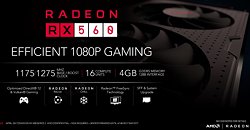Thursday, December 7th 2017

AMD Issues Official Statement Regarding RX 560 Silent Downgrade
AMD has come forward with a statement regarding the state of things as it purports to the recent RX 560 downgrade issue, which has been covered extensively by media outlets just this week. The issue stems from the fact that there was no clear differentiator between two different versions of AMD's RX 560 graphics card, which could ship with two different levels of performance: one with 14 CUs (Compute Units) enabled (896 stream processors) or 16 (1024 stream processors, the original specification for the card).
"It's correct that 14 Compute Unit (896 stream processors) and 16 Compute Unit (1024 stream processor) versions of the Radeon RX 560 are available," stated a company representative. "We introduced the 14 CU version this summer to provide AIBs and the market with more RX 500 series options. It's come to our attention that on certain AIB and e-tail websites there's no clear delineation between the two variants. We're taking immediate steps to remedy this: we're working with all AIB and channel partners to make sure the product descriptions and names clarify the CU count, so that gamers and consumers know exactly what they're buying. We apologize for the confusion this may have caused."While it's true that AMD is now dealing with the situation openly, the company itself isn't completely blameless on the issue. AMD's own RX 560 product page lists the two possible configurations (14 and 16 CU) absent of any further differentiation in product name. At the same time, AMD could have better enforced differentiation opportunities with its AIB partners upon supplying them with both versions of the GPU. As it stands, some users have been unwittingly buying a lower performing part than what was initially advertised by AMD. While this new transparent stance from AMD is refreshing, it doesn't do much regarding already affected customers. Of course, if users suspect or want to check whether or not they have purchased the higher performance version of the card (16 CUs), they can perform a GPU verification with TechPowerUp's GPU-Z tool.
Source:
Tom's hardware
"It's correct that 14 Compute Unit (896 stream processors) and 16 Compute Unit (1024 stream processor) versions of the Radeon RX 560 are available," stated a company representative. "We introduced the 14 CU version this summer to provide AIBs and the market with more RX 500 series options. It's come to our attention that on certain AIB and e-tail websites there's no clear delineation between the two variants. We're taking immediate steps to remedy this: we're working with all AIB and channel partners to make sure the product descriptions and names clarify the CU count, so that gamers and consumers know exactly what they're buying. We apologize for the confusion this may have caused."While it's true that AMD is now dealing with the situation openly, the company itself isn't completely blameless on the issue. AMD's own RX 560 product page lists the two possible configurations (14 and 16 CU) absent of any further differentiation in product name. At the same time, AMD could have better enforced differentiation opportunities with its AIB partners upon supplying them with both versions of the GPU. As it stands, some users have been unwittingly buying a lower performing part than what was initially advertised by AMD. While this new transparent stance from AMD is refreshing, it doesn't do much regarding already affected customers. Of course, if users suspect or want to check whether or not they have purchased the higher performance version of the card (16 CUs), they can perform a GPU verification with TechPowerUp's GPU-Z tool.


95 Comments on AMD Issues Official Statement Regarding RX 560 Silent Downgrade
THEY SHOULD HAVE NOT DONE SO.
Here is a list with articles about Nvidia's misleading branding: Nvidia GT 730 articles
And here is Nvidia's apology: Nvidia explains the three models of GeForce GT 730
AMD doing shit is not justified by that, clear let down, boo, AMD...
AMD you were the light, the shining beacon of goodness! Noooooooo!
But let's ignore the already ignored ancient practice of having the same name for different products and spin it in such a way to make it look like a good thing. :laugh:
Mine has:
1GB DDR3
384 CUDA
64bit bus
12.8GB/s bandwidth
800MHz memory
I'm not caring one way or the other about it's overall performance since I have it in my work computer, but I just thought I'd point it out that she's different over the three listed in your pic.
After all the looking around it looks like the version I have is a mix between a GT 720 and a GT 730 of some sorts....I can't really find any legit posting of this particular model on wikipedia or nvidia.....oh well, it was cheap and did what I needed from it....plus, it's better over the crappy HD 2500 onboard my work computer was using.
Heck, I just went and benched my super powered work computer on 3DMark SkyDiver and compared it to another i3-3220 running just the onboard HD 2500, noticeable difference: www.3dmark.com/compare/sd/4914831/sd/2980398#
The only news here is AMDs partners are not labeling the cards as AMD has specified. The existence of the 560D has been known since June. They were also supposed to be region "locked."
And even if we ignore the Fermi version you can't sell under the same name a card with 64bit DDR3 and a card with 64bit GDDR5. The bandwidth difference is huge. In the past that kind of bandwidth difference was enough to justify two DIFFERENT models. GT 640 and GTX 650.No it doesn't. As I think I make it clear, it was a bad idea from AMD. By now, they should have known to been much more careful and not think like thisYour card is the worst of these three models available in 3D performance. Looking at features is probably better than the Fermi model. It's that "LOL BAD" version in the screenshot I posted. It does have a Kepler GPU, it does have 384 CUDA cores, but it also comes with only - in your case - 12.8GB/sec memory bandwidth. It's lower than those 14.4GB/sec on Nvidia's specs page, because when GT 730 came out the specs where talking about DDR3 memory running at 1800MHz.
In typical day usage scenarios - don't know about CUDA, you might not notice any difference, but a model with GDDR5 memory would be killing your card in 3DMark.
This is fucking Gross AMD...
Very very gross.
VIA master race.
Also - you can see in your little screenshot a full spec list, including shader counts, memory bus etc. and these details are 100% correct. Let's fast forward to Intel's Skylake versus its Kaby Lake parts, now, or give their new i3 quadcore parts the middle finger because they're actually last years' i5 stack.... This is really quite normal. AMD has also been re-releasing Pitcairn until infinity, re-rebranding a whole product stack from HD- to R9, hell I could give you a dozen more examples of any hardware company.
Bottom line, your example makes no sense at all and its not the place.
And this one's for you @RejZoR
www.tomshardware.com/news/MSI-GTX-660-670-overvolting-PowerEdition,18013.html
Nobody is clean
With the GT730, that was literally a bottom of the barrel card. AND they released all the versions of the card at the same exact time. So everyone knew they existed from day one, and you knew what to look for. If reviewers reviewed the card, they knew to look at the version and let people know which one they were reviewing. (Did any major site ever even review the GT730?) Plus, the target demographic wasn't gaming, if you tried to game on a GT730, I feel bad for you, every version of that card was shit.
But AMD released a model on the market, then later on released another weaker card under the same name. This is very different from what nVidia did, and worse. It also isn't the first time they've released a card, let it be reviewed, then reduced the performance. They've been pulling that shit since at least 2008...
The fundamental problem is the fact that amd changed the specs on the website so the same name card has two different specs. 560d was asia... in the us its jusst a 560. The 1060 on nvidias website, clearly shows that the specs are different.
This will look familiar to vya... lol....Incoming car analogy!!!
NVIDIA - You can buy a base Mustang (1060 3gb) and a Mustang GT (1060 6gb)
Your argument - they are both called a Mustang and we cant differentiate easily enough. However if i look it up, clearly we can tell there is a difference..see specs.
www.nvidia.com/en-us/geforce/products/10series/geforce-gtx-1060/
AMD - You can buy a Mustang GT only...however you arent sure what motor is in it, the slower 6 cyl turbo or the 5.0L, and cant tell until you get it home and check. The specs from the factory show both motors for the same car and trim level, no help there.
Argument - Those dealerships are being shady even though the ford factory itself has it listed incredibly ambiguous. Ok.. its not ambiguous, it is clear there are two specs for the same card...no "d"
www.amd.com/en/products/graphics/radeon-rx-560
While nvidias naming scheme could most certainly be made more clear, it is a different situation as nvidia makes it clear there is a difference starting from their website on down to the card partners.
Edit: and please stop the random nvidia injection into these threads. We get it... :)
Stay on topic! We all know Nv are amazingly evil and far more successful, but lets focus on AMD:
products.amd.com/en-us/search/desktop-graphics/radeon%E2%84%A2-rx-series/radeon%E2%84%A2-rx-500-series